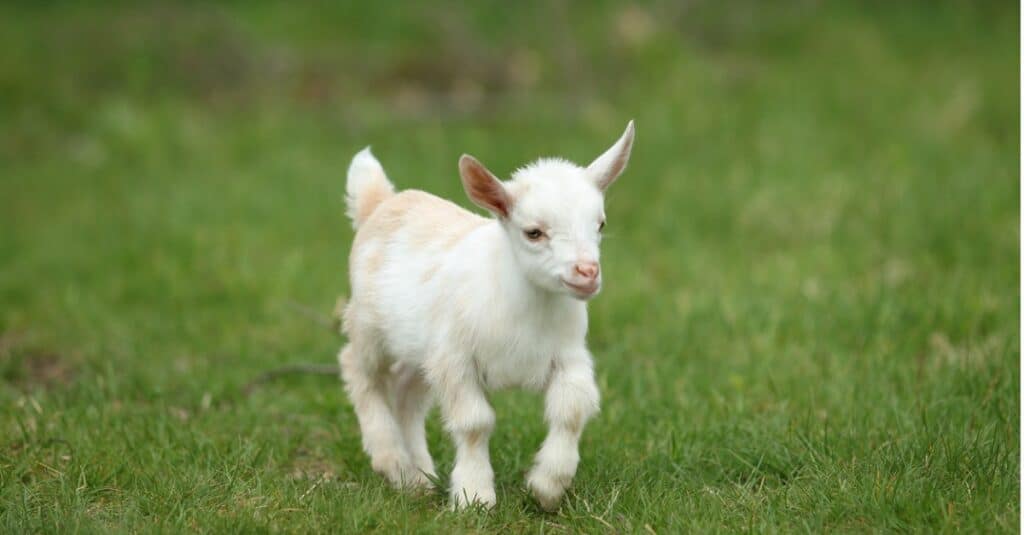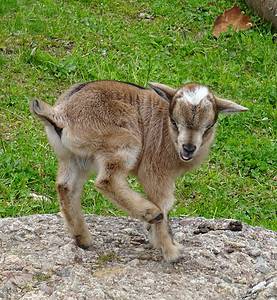In the animal kingdom, horns are symbols of dominance and power. While males usually sport these impressive growths, this is not a hard-and-fast rule. Female reindeer, for example, grow horns right along with the males. So what about goats? Do female goats have horns, and what do they use them for? Read on to find out!

Both female and male goats have horns, though some goats are born without them or have them removed.
©iStock.com/aurorat
Do Female Goats Have Horns?
Both female and male goats have horns. Typically, the horns of females are somewhat shorter and thinner than those of males. The idea that hornless goats are automatically female is false.
Goat horns come in different shapes depending on the breed: straight horns, curved horns, and corkscrew horns. An example of a goat breed with straight horns is the pygmy goat. Goat breeds with curved horns include Nubian goats and Boer goats. The Markhor and Girgentana breeds, on the other hand, feature massive corkscrew horns.
Differences Between Male and Female Goats
The best way to tell the difference between a male and female goat is by looking under the tail. Both male and female goats have anuses, which account for the single hole under a male goat’s tail. However, females have a second hole below the first. This is the vagina, used for mating and giving birth. In addition to this, uncastrated male goats have scrotums while females have udders.
Male goats of all breeds are typically larger and heavier than females with bigger horns. They also tend to have longer beards, though female goats often have goatees. Another way to tell the sexes apart is by smell. Female goats are generally odourless, but uncastrated male goats during mating season give off a pungent odour from their sex glands to attract mates.
Do Baby Goats Have Horns?
Baby goats, or kids, are born without horns. The birthing process would be extremely difficult, if not impossible, if kids had horns in the womb. However, most newborn goats already have horn tissue that develops into visible horn nubs by about 3 weeks of age.
Some goat owners prevent horns from growing on their goats using a method called “disbudding.” This is the process of destroying the horn tissue before it can attach to the skull and develop into horn buds. The purpose is to prevent goats from injuring themselves or others with their horns and to prevent the destruction of property.
In order for disbudding to be effective, it must be completed before the goats reach 3 weeks of age. It is achieved by cauterization, either by using a hot iron or caustic paste. Unfortunately, this procedure is painful for the goat and can cause health complications. For these reasons, it remains controversial.
What Are Goat Horns Made Of?
Goat horns are made of both bone and keratin. Live bone forms the core of the horn and includes blood vessels, tissue, and nerves. Keratin forms the outer layer, providing a protective sheath. Keratin is the same substance present in hair, fingernails, claws, and hooves. Goat horns are rigid and strong, able to withstand a large application of force.
Because of the nerves in the bone core, horn removal (dehorning) is extremely painful for the goat. If goat owners wish to remove their goats’ horns, experts recommend disbudding instead as it is somewhat less traumatic and risky. Both dehorning and disbudding have drawn their share of backlash from animal rights activists.

Markhor goats have impressive horns that can grow up to 63 inches in length.
©BearFotos/Shutterstock.com
Goats with the Biggest Horns
Some goat species have truly impressive horns that would make any contender think twice about engaging in a headbutt. One example is the Markhor goat. Its corkscrew horns can grow up to 63 inches on the males, though females’ horns usually only measure up to 9.8 inches in length. They arch backward or to either side with a distinctive spiral, earning this animal the name “screw-horned goat.”
A goat named Rasputin holds the world record for the goat with the biggest horn spread. He’s a male Walliser black-necked goat with a reputation for gentleness despite his fierce accoutrements. From tip to tip, his horns measure 53.23 inches.
Goats with the Smallest Horns
Dairy goats tend to have smaller horns than goats kept for other purposes. Breeds with small horns include Nubian goats, Guernsey goats, Nigerian dwarf goats, and Alpine goats.
Goats with No Horns
Polled goats are goats born without horns. Though this is fairly uncommon in goats, it’s normal for their relatives, sheep, to be born hornless. Many goat owners deliberately breed their goats to produce polled kids by selecting for the associated recessive gene. Naturally hornless goats do not need to be disbudded or dehorned, avoiding much pain and effort. Unfortunately, polled kids are often born sterile or as hermaphrodites (having both sets of sex organs). This makes them less valuable.
No goat breed is entirely polled. However, some breeds are likelier to produce polled kids than others. These include Toggenburg, LaMancha, and Nigerian Dwarf goats.
Do Goats Lose Their Horns?
Unlike many other horned species like moose, reindeer, and caribou, goats do not shed their horns. Once the horns come in, they are permanent, continuing to grow in size throughout the goat’s life. In fact, it is possible to tell the age of a goat by counting the annual growth rings on its horns.
Despite not shedding their horns, goats may lose them in other ways. Butting another animal or object is one common cause. This often causes splintering, which can be painful and dangerous. Another way goats lose their horns is by catching them in fences. The struggle to pull them free may cause trauma to the horn.

All baby goats are born without horns. By 3 weeks of age, horn nubs appear on their heads.
©iStock.com/flySnow
Do Goats Fight with Their Horns?
Male goats occasionally spar with their horns, though this is less common than one might think. They typically establish dominance without resorting to jabbing each other. This includes displays of aggression such as lowering their heads and pointing their horns. If a rival goat persists in a challenge, the males may resort to headbutting and pushing. Dominant goats will occasionally butt other males to remind them of their place in the social order.
When faced with a predator, goats will usually flee rather than fight. Staying in large groups helps them avoid dangerous situations. If cornered, however, both male and female goats may use their horns to deter an attacker. Common predators include coyotes, wolves, bobcats, mountain lions, and bears.
Goats rarely attack their humans. In fact, both males and females use head butts as a means of expressing happiness, playfulness, or affection. Most incidents of impalement are accidents.
Female goats do indeed grow horns along with the males, but rest assured: they’re highly unlikely to use them against you!
The photo featured at the top of this post is © iStock.com/VeraOsco
Thank you for reading! Have some feedback for us? Contact the AZ Animals editorial team.







